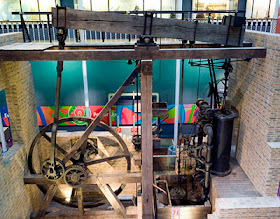Michael Castle, my 4x great uncle, was part of a powerful merchant family in 18th century Bristol. He was a whisky distiller in partnership with his older brother Robert and a third businessman called John Ames. Together they ran several public houses as well as the Bristol Distillery; and when Robert died (while in office as mayor of Bristol in 1803), Robert and Michael’s younger brother Thomas, my 3x great grandfather, took his place in the partnership.
Michael Castle (1762-1821)
modern manufacturer
I’ve written about the distillery previously here. Recently I found out that the distillery was a modern operation, employing state-of-the-art technology – the energy source which powered the Industrial Revolution. In 1793 Castle & Ames took delivery of a mighty Boulton & Watt beam engine.
It was the largest of three Boulton &Watt “sun-and-planet” machines known to have been supplied to manufacturers in the city of Bristol in the 1790s. Sixteen engineering drawings for the Castle and Ames machine survive in the archives of Boulton and Watt, held by Birmingham Central Library. Sun-and-planet refers to the gearing mechanism, one wheel revolving around another, which transferred the up-and-down vertical motion of a beam engine onto a round-and-round horizontal drive shaft.
Matthew Boulton (1728-1809) and James Watt (1736-1819)
both painted by Carl Frederik von Breda in 1792,
the year before they supplied Castle & Ames
The Watt in Boulton & Watt is James Watt, the Scottish engineer who improved the efficiency of steam engines beyond all recognition when he was asked to repair an early machine at Glasgow University in 1763. Watt the mechanical genius understood his limitations as an entrepreneur, and to realise the full potential of his innovations he went into partnership with Matthew Boulton, a Birmingham manufacturer.
In 1776 Boulton & Watt began producing engines which used only 25% of the fuel of previous steam engines. They transformed the industrial landscape not only by producing a more efficient, powerful machine but by cutting industry’s ties to other forms of power. In particular, factories no longer had to be positioned near a suitable head of water to drive the water wheels which had previously been the best source of energy.
Boulton & Watt engine
originally supplied to Barclay & Perkins Brewery, Southwark
(now in the National Museum of Scotland) -
sun-and-planet gear clearly visible
Boulton & Watt manufactured 450 engines between 1776 and 1800. They were used in a broad range of settings to drive other machinery or to pump water. In Bristol, besides the Castle & Ames distillery, engines were supplied to a woolen manufactory and a lead works. I don’t know exactly how the Castle & Ames one was applied in their production of strong spirits; but a surviving Boulton & Watt sun-and-planet engine now in the National Museum of Scotland was originally used in a London brewery to grind barley and pump water.
Boulton & Watt continued to develop new models, and in April 1823 the Bristol distillery, now known as Thomas Castle & Co following the death of both Robert and Michael, ordered a new larger crank-type beam engine from them, for which again drawings survive in Birmingham Library. As a measure both of the distillery’s progress and Boulton & Watt’s, the new engine had a six-foot stroke compared to the old one’s five; and where the old one delivered in the region of 15 horse power, Thomas Castle’s new machine was capable of a whopping 40 h.p. Matthew Boulton summed it up when he boasted to the diarist James Boswell who was touring his factory in Soho, Birmingham: "I sell here, sir, what all the world desires to have - POWER."




No comments:
Post a Comment